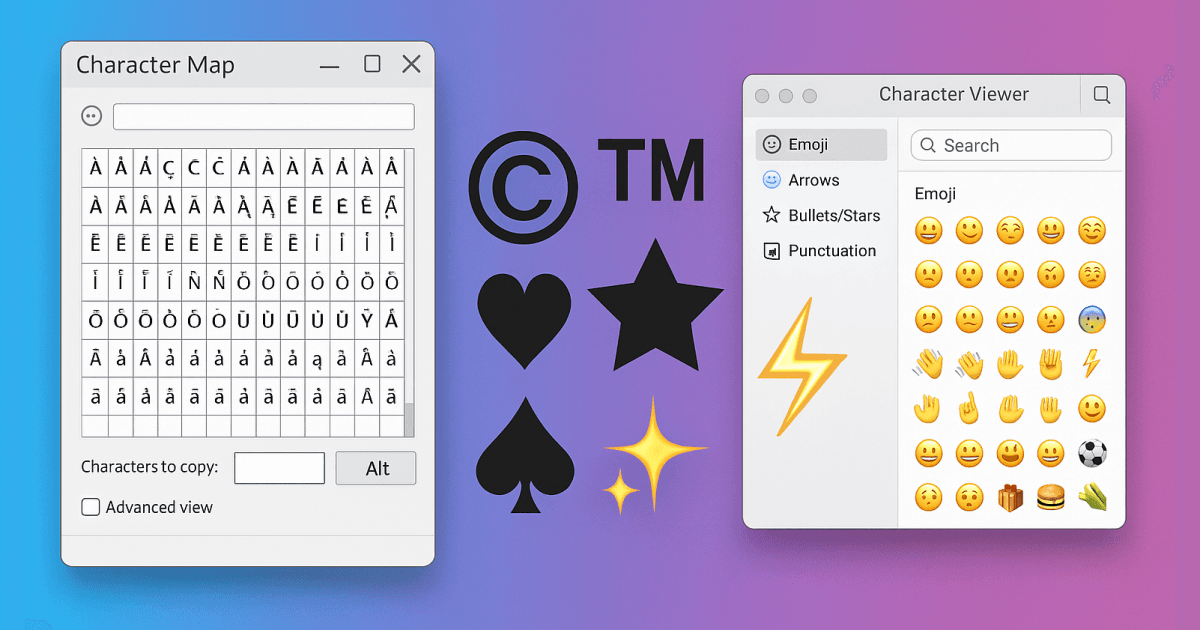How to Type Unicode Characters: Complete Guide for Every Platform

Unicode characters open up a world of possibilities for digital communication, allowing you to express ideas beyond the basic alphabet. Whether you're a developer, designer, or simply someone who loves using unique symbols, mastering Unicode input can transform how you communicate online.
Table of Contents
- What is Unicode and Why Should You Care?
- How to Type Unicode on Windows
- How to Enter Unicode on Mac
- How to Insert Unicode on Linux
- Universal Unicode Methods
- Advanced Unicode Techniques
- Creative Applications of Unicode
- Troubleshooting Unicode Issues
- Best Practices for Unicode Usage
- The Future of Unicode
- Making Unicode Part of Your Workflow
What is Unicode and Why Should You Care?
Unicode is a universal character encoding standard that represents virtually every character from every writing system in the world. Think of it as a massive library containing over 140,000 characters, including emojis, mathematical symbols, foreign alphabets, and decorative elements.
Unlike the limited ASCII character set that only includes basic English letters and numbers, Unicode encompasses everything from ancient hieroglyphs to modern emoji. This comprehensive system ensures that text appears consistently across different devices, platforms, and applications.
The Unicode Consortium maintains this standard, continuously adding new characters and improving compatibility. It's like having a universal translator for every symbol humanity has ever created - except instead of languages, it translates between different computer systems.
For creative professionals and everyday users alike, Unicode provides access to typography that goes far beyond standard keyboards. You can create eye-catching social media posts, enhance documents with special formatting, or add professional symbols to technical writing.
How to Type Unicode on Windows
Windows offers several methods for entering Unicode characters, each suited for different situations and user preferences.
Using Alt Codes
The most traditional method involves Alt codes, which work by holding the Alt key while typing a numeric sequence on the number pad. This method works reliably across most Windows applications.
For example, Alt+0169 produces the copyright symbol ©, while Alt+0174 creates the registered trademark symbol ®. The key is using the numeric keypad, not the number row at the top of your keyboard.
Windows Character Map
Windows includes a built-in Character Map utility that provides a visual interface for Unicode selection. Access it by searching "Character Map" in the Start menu. This tool displays available characters in any installed font, making it perfect for browsing and discovering new symbols.
The Character Map shows the Unicode value for each character, allowing you to learn codes for frequently used symbols. You can also copy characters directly from the map into your documents. Fun fact: the Character Map has been around since Windows 3.1 - it's older than most memes, but somehow still more useful than half the apps on your phone.
Windows Unicode Input Method
For more advanced users, Windows supports direct Unicode input using the registry. After enabling this feature, you can type Unicode values directly by holding Alt and typing the hexadecimal code on the numeric keypad.
This method requires some technical setup but provides the most comprehensive access to Unicode characters. It's particularly useful for developers and designers who work with Unicode regularly.
How to Enter Unicode on Mac
Mac systems provide elegant solutions for Unicode input, reflecting Apple's focus on user-friendly design.
Option Key Combinations
The Option key (Alt on some keyboards) serves as your gateway to extended characters on Mac. Option+e followed by a vowel creates accented characters, while Option+c produces the copyright symbol ©.
Many common symbols have memorable Option key combinations. Option+2 creates the trademark symbol ™, Option+r produces the registered symbol ®, and Option+shift+k generates the Apple logo .
Character Viewer
Mac's Character Viewer provides a comprehensive interface for Unicode selection. Access it through Edit > Emoji & Symbols in most applications, or use the keyboard shortcut Control+Command+Space.
The Character Viewer categorizes characters by type, making it easy to find specific symbols. You can search for characters by name, browse categories, or view recently used characters for quick access.
Mac Unicode Hex Input
For direct Unicode input, enable the Unicode Hex Input keyboard in System Preferences. This allows you to type Unicode values directly by holding Option and typing the hexadecimal code.
This method provides access to the full Unicode range and is particularly valuable for technical users who need specific character codes.
How to Insert Unicode on Linux
Linux systems offer powerful Unicode support through various methods, reflecting the platform's flexibility and customization options.
Compose Key Method
Many Linux distributions support compose key sequences, which allow you to create Unicode characters by combining multiple keystrokes. After pressing the compose key, you type a logical sequence that represents the desired character.
For example, compose + c + o creates the copyright symbol ©, while compose + t + m produces the trademark symbol ™. These sequences are often intuitive and easy to remember.
GTK Applications
Applications built with GTK (including many popular Linux programs) support Unicode input through Ctrl+Shift+U followed by the hexadecimal Unicode value. This method works consistently across GTK applications and provides access to the full Unicode range.
IBus and Other Input Methods
Linux supports various input method frameworks like IBus, which can be configured for Unicode input. These systems provide sophisticated input capabilities and can be customized for specific workflows or language requirements.
Universal Unicode Methods
Some Unicode input methods work across multiple platforms and applications, providing consistent access regardless of your operating system.
Web-Based Unicode Tools
Online Unicode tools and character pickers work in any web browser, making them platform-independent solutions. These tools often provide search functionality, character previews, and easy copy-paste access.
Many font generators include Unicode character support, allowing you to create stylized text with special symbols. These tools are particularly useful for social media content and creative projects.
Application-Specific Methods
Many applications provide their own Unicode input methods. Microsoft Word includes symbol insertion tools, while Google Docs offers special character menus. These built-in features often provide the most seamless Unicode input experience within specific applications.
Understanding Unicode Values and Codes
Unicode characters are identified by unique code points, typically written in hexadecimal format. Understanding these codes helps you access characters directly and troubleshoot input issues. According to the Unicode Standard, each character has a specific position in the Unicode space.
Hexadecimal Notation
Unicode code points are written as U+XXXX, where XXXX represents the hexadecimal value. For example, U+00A9 represents the copyright symbol ©, while U+2122 represents the trademark symbol ™.
Learning common Unicode ranges helps you navigate the character space more effectively. Basic Latin characters occupy U+0000 to U+007F, while Latin-1 Supplement ranges from U+0080 to U+00FF. Don't worry if hexadecimal sounds scary - it's just counting in base 16 instead of base 10. Think of it as regular counting, but with more letters and a tendency to confuse math teachers.
Character Blocks and Ranges
Unicode organizes characters into logical blocks based on script, purpose, or origin. Mathematical symbols occupy specific ranges, while emoji characters have their own designated blocks. You can explore these ranges in detail on Wikipedia's Unicode block list.
Understanding these organizational principles helps you locate related characters and discover new symbols for your projects. The Unicode Character Database provides comprehensive information about each character's properties and relationships.
Advanced Unicode Techniques
For power users and developers, advanced Unicode techniques provide sophisticated text manipulation capabilities.
Combining Characters
Some Unicode characters combine with preceding characters to create composite symbols. Combining diacritical marks allows you to add accents and modifications to base characters, creating customized text effects.
Normalization Forms
Unicode supports multiple representation forms for some characters, allowing flexibility in how text is encoded and displayed. Understanding normalization helps ensure consistent text processing across different systems.
Programming with Unicode
Developers working with Unicode need to understand encoding schemes like UTF-8 and UTF-16. These technical aspects ensure proper character handling in applications and databases.
Creative Applications of Unicode
Unicode characters enable creative expression beyond basic typography, opening new possibilities for digital art and communication.
Social Media Enhancement
Unicode symbols can transform plain social media posts into visually appealing content. Decorative elements, mathematical symbols, and special characters help posts stand out in crowded feeds.
Using cool fonts and bold text generators can create eye-catching posts that engage audiences more effectively than plain text.
Document Formatting
Professional documents benefit from proper Unicode usage for trademarks, copyright notices, and mathematical expressions. Using correct Unicode characters ensures documents appear professional and legally compliant.
Artistic Text Creation
Unicode includes numerous decorative characters that can be combined to create text art and visual effects. These characters enable creative expression within text-based mediums.
Troubleshooting Unicode Issues
Common Unicode problems have straightforward solutions once you understand the underlying causes.
Font Support
Not all fonts include every Unicode character. Missing characters typically appear as boxes or question marks. Using fonts with comprehensive Unicode support resolves most display issues.
Input Method Problems
Unicode input methods sometimes conflict with other keyboard software or system settings. Disabling conflicting programs or adjusting input method priorities usually resolves these issues.
Encoding Issues
Text encoding problems can cause Unicode characters to display incorrectly. Ensuring consistent UTF-8 encoding across your workflow prevents most character corruption issues.
Best Practices for Unicode Usage
Following established practices ensures reliable Unicode usage across different platforms and applications.
Consistency
Use consistent Unicode input methods within projects to maintain workflow efficiency. Switching between different input methods can slow down your work and increase error rates.
Documentation
Keep records of frequently used Unicode characters and their codes. This documentation saves time and ensures consistent character usage across projects.
Testing
Test Unicode characters across different platforms and applications before finalising projects. Some characters may display differently or not at all in certain contexts.
The Future of Unicode
Unicode continues evolving to meet changing communication needs, with regular updates adding new characters and improving existing functionality.
Emoji Evolution
New emoji characters are added regularly, reflecting cultural changes and user demands. The Unicode Emoji Subcommittee reviews proposals and determines which new emoji join the official standard. Understanding the emoji update process helps you stay current with the latest symbols.
Yes, there's actually a committee that decides whether we get a new taco emoji or not. Imagine having "Professional Emoji Decider" on your business card - now that's a conversation starter at parties!
Technical Improvements
Unicode standards continue improving to handle edge cases and enhance compatibility across different systems and applications.
Making Unicode Part of Your Workflow
Successfully integrating Unicode into your daily workflow requires practice and the right tools.
Start Simple
Begin with commonly used Unicode characters and gradually expand your repertoire. Focus on characters relevant to your specific needs and interests.
Use Tools Effectively
Leverage symbol text generators and other Unicode tools to streamline your workflow. These resources can save time and provide inspiration for creative projects.
Practice Regularly
Regular practice with Unicode input methods builds muscle memory and improves efficiency. Set aside time to experiment with new characters and techniques.
Unicode mastery opens doors to enhanced digital communication and creative expression. Whether you're crafting professional documents, creating social media content, or developing applications, understanding Unicode input methods empowers you to communicate more effectively in our increasingly connected world. Start with the basics, practice regularly, and gradually explore the vast possibilities that Unicode characters offer.

VibeBerry Team